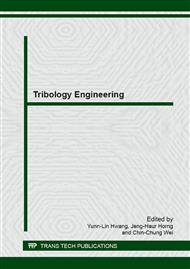p.217
p.222
p.227
p.231
p.236
p.242
p.248
p.253
p.259
The Study of Band Sawing Vibration and Cutting Performance
Abstract:
Band saws machine is the most efficient metal cutting machine. By losing less material, material qualitative, having big saw range and having low cutting costs are superiority of band saws. Band saws are acting with most long route and more limited support point in all cutting tools. In band sawing machine, band saws and structure are easy to produce vibration. Affect cutting life, costs of band saws and material surface topography. So this study focuses on analyzing what is vibration cause of band saws by vibration source and establishes the relationship between band saws natural frequency along and change cutting condition. In this research use the C-430GNC band saws machine, and use S45C material for cutting test. Accelerometers are used with a measurement system to capture sawing vibration data. By the fast Fourier transform to analyze spectrogram transform in order to identified characteristic spectrums, and find out vibration feature with band sawing operating conditions and unusual evens came from wear of blade. Minimum cutting vibration and best surface topography were compared to find out the best cutting condition.
Info:
Periodical:
Pages:
236-241
Citation:
Online since:
April 2015
Authors:
Keywords:
Price:
Сopyright:
© 2015 Trans Tech Publications Ltd. All Rights Reserved
Share:
Citation:


